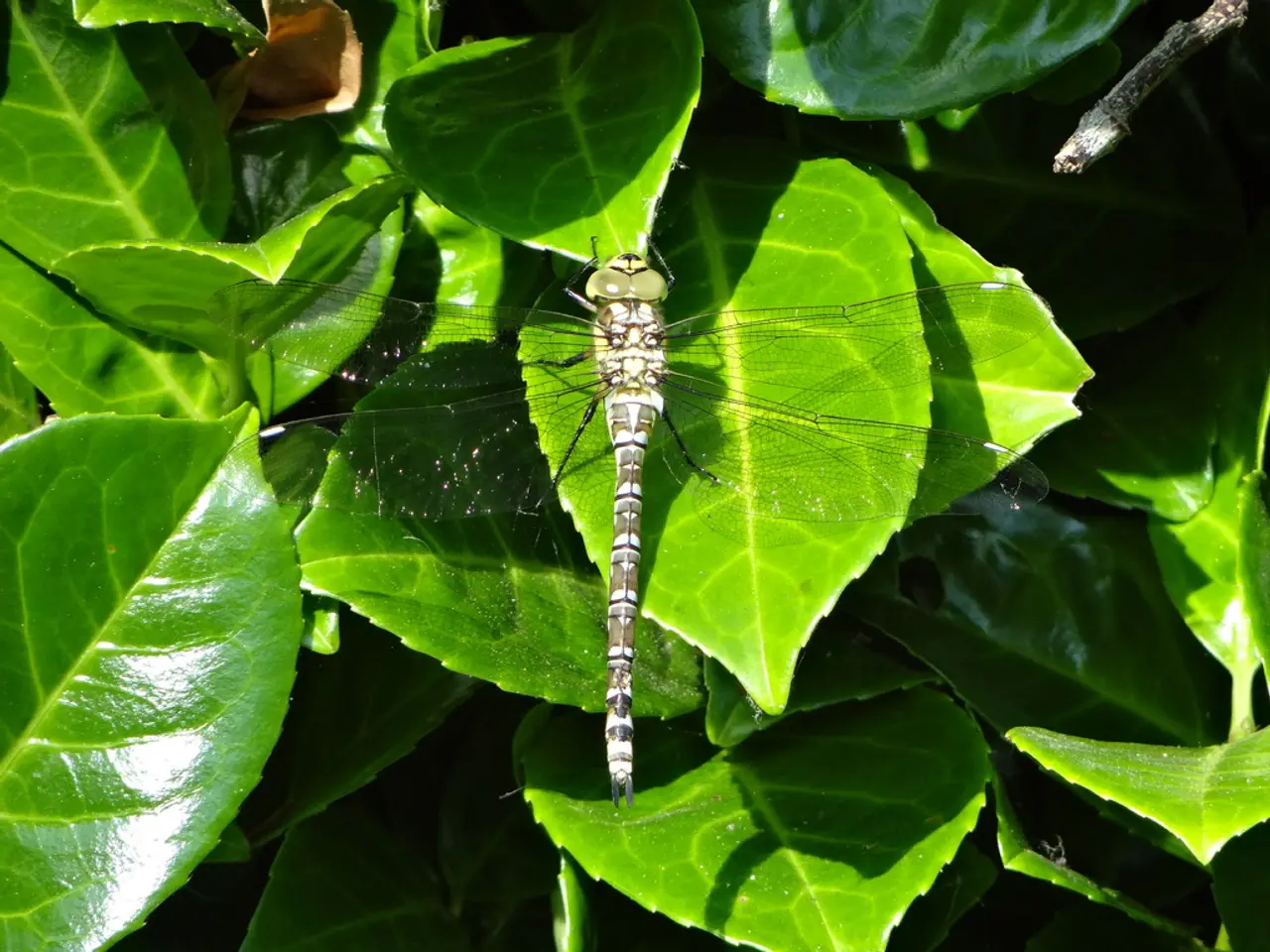Chikungunya virus outbreaks in China: Essential information you need
The southern Guangdong province of China is currently grappling with a significant outbreak of the chikungunya virus (CHIKV), with nearly 3,000 cases reported in the last week alone, marking the largest such outbreak ever documented in China[1][2][3]. The outbreak, centred around Foshan, has prompted urgent containment efforts from authorities.
The current outbreak is linked to environmental factors like monsoon flooding and the typhoon season, which have increased mosquito breeding and activity[3][4]. In response, China has implemented a series of preventive and containment measures inspired by COVID-19 tactics.
Quarantine and isolation of infected individuals have been intensified, with increased mosquito-proof isolation beds[1][2][4]. Drones are being used for fogging and spraying disinfectants in residential, public, and construction areas to kill mosquitoes[1][2][4]. Legal enforcement is also in place, with fines of up to about 10,000 yuan ($1,400) and even electricity cuts for those who fail to eliminate standing water breeding grounds[2].
In addition, the use of mosquito nets, coils, and repellents, as well as the release of biological control agents such as larvae-eating fish and non-biting "elephant mosquitoes" that prey on Aedes mosquitoes, the main vector for chikungunya, have been implemented[4]. Mass testing and household inspections are also being carried out to enforce compliance with mosquito control[1][4].
No vaccine for chikungunya is yet publicly available in China, but vaccination is recommended for travelers to affected regions according to the CDC[3][4]. Globally, about 240,000 chikungunya infections have been reported in 2025, including cases in the Americas, Africa, Asia, and Europe, highlighting the wider challenge of this mosquito-borne virus beyond China[3][5].
In other affected regions, prevention emphasizes avoiding mosquito bites with protective clothing, insect repellents containing DEET, and mosquito netting, especially for vulnerable groups like children and older adults[3]. Public health authorities also promote mosquito source reduction—removal of standing water and environmental sanitation[1][3][4]. Travelers are advised to take protective measures, and vaccination exists though availability varies by country[3].
China’s aggressive containment reflects the seriousness of this outbreak and its potential to spread swiftly through local transmission rather than isolated imports seen previously[1][4]. This outbreak is a significant public health event in East Asia, with concerns of further spread linked to environmental and climatic conditions[1][4].
Authorities in Guangdong are conducting door-to-door home inspections to eliminate stagnant water, where mosquitoes breed. The CDC warns that U.S. travelers visiting Brazil, Colombia, India, Mexico, Nigeria, Pakistan, Thailand, and the Philippines are at an elevated risk of exposure to Chikungunya[6]. As of 2025, there have been 46 travel-associated Chikungunya cases in the United States[7].
The joint pain caused by chikungunya can persist for months or years. Chikungunya can only be transmitted to a person through the bite of an infected mosquito and is not contagious or transmittable person to person[8]. Measures similar to those used during the COVID pandemic have been instituted in Guangdong, including hospital quarantine for infected patients[9].
Chikungunya is a rarity in China but has spread after an imported case was detected in Foshan city on July 8[10]. Hong Kong reported its first case of Chikungunya in a 12-year-old boy on Monday[11]. Other precautions taken include introducing giant "elephant mosquitoes" and releasing mosquito-eating fish into local ponds[4].
The CDC only recommends the Chikungunya vaccine for people traveling to an area with a Chikungunya outbreak[12]. The CDC issued a Level 2 travel alert for Foshan city and recommends any traveler to the area be vaccinated[13]. There are two approved Chikungunya vaccines in the United States: IXCHIQ and VIMKUNYA[14].
Chikungunya presents most commonly with a headache, muscle pain, nausea, fatigue, rash, and swollen joints[15]. Those who fail to cooperate with inspections can be fined or face criminal charges for "obstructing the prevention of infectious diseases."
[1] https://www.reuters.com/world/china/china-reports-3000-new-chikungunya-cases-in-southern-guangdong-province-2021-07-20/ [2] https://www.scmp.com/news/china/society/article/3139836/china-introduces-new-measures-fight-chikungunya-outbreak-guangdong [3] https://www.cdc.gov/chikungunya/index.html [4] https://www.reuters.com/world/china/china-deploys-drones-in-fight-against-chikungunya-outbreak-2021-07-19/ [5] https://www.who.int/news-room/fact-sheets/detail/chikungunya [6] https://wwwnc.cdc.gov/travel/notices/warning/chikungunya-china [7] https://wwwnc.cdc.gov/travel/notices/alert/chikungunya-virus-in-us-territories [8] https://www.who.int/news-room/q-a-detail/chikungunya-virus [9] https://www.reuters.com/world/china/china-introduces-new-measures-fight-chikungunya-outbreak-guangdong-2021-07-20/ [10] https://www.scmp.com/news/china/society/article/3139836/china-introduces-new-measures-fight-chikungunya-outbreak-guangdong [11] https://www.scmp.com/news/hong-kong/health-environment/article/3148432/hong-kong-reports-first-case-chikungunya-virus-12-year [12] https://wwwnc.cdc.gov/travel/yellowbook/2020/infectious-diseases-related-to-travel/chikungunya-virus-infection.htm [13] https://wwwnc.cdc.gov/travel/notices/alert/chikungunya-virus-in-us-territories [14] https://www.fda.gov/vaccines-blood-biologics/vaccines/chikungunya-vaccines [15] https://www.cdc.gov/chikungunya/symptoms/index.html
- The science behind chikungunya virus (CHIKV) and its impact on global health is a subject of concern in the medical-conditions and environmental-science industries.
- Chronic diseases, such as chikungunya, pose challenges in the workplace-wellness sector due to their long-term effects on employee health.
- Respiratory conditions, skin-conditions, and eye-health are other areas of focus in the health-and-wellness industry.
- Fitness-and-exercise, nutrition, and activities promoting sustainable-living are also integral parts of the health-and-wellness industry.
- The manufacturing industry is exploring technologies to address climate-change concerns, including the production of energy-efficient products.
- Mental-health issues are gaining prominence in the retail, entrepreneurship, and interior-design sectors, with a growing emphasis on creating calm and comforting spaces.
- Skin-care, a subsector of the cosmetics and fashion-and-beauty industry, is investing in research for therapies-and-treatments for various skin conditions.
- In the finance industry, sustainable investments are becoming increasingly popular, targeting environmental and social causes, including climate-change solutions.
- The environmental-science field is studying the impact of climate-change on various industries, including transportation, where shifts towards electric vehicles are being considered.
- Leadership in businesses requires an understanding of diversity-and-inclusion, promoting a more inclusive workplace culture and product offerings.
- The wellness-focused startup ecosystem incorporates smart-home-devices and wearables, such as fitness trackers and air purifiers, to improve lifestyle and home-and-garden living.
- The housing-market is adapting to changing consumer preferences, with a growing demand for outdoor-living spaces.
- In the automotive industry, artificial-intelligence (AI) and robotics are being leveraged for designing fuel-efficient vehicles and autonomous transportation systems.
- Small-business owners focus on personal-finance management and debt-management to ensure the sustainability of their ventures.
- Wealth-management firms offer investing strategies and services to help individuals build and manage their wealth, considering diverse asset classes such as real-estate, gadgets, and smartphones.
- Banking-and-insurance sectors provide insurance coverage for various risks, including health, property, and entrepreneurial endeavors.
- Real-estate developers incorporate data-and-cloud-computing to optimize construction projects and improve the energy-efficiency of buildings.
- The stock-market is influenced by economic indicators, political events, and technological trends, impacting investor decisions.
- Saving and budgeting are crucial elements in personal-finance management for individuals and families.
- Cybersecurity is a significant concern for both businesses and consumers, necessitating the protection of personal and financial data.
- Lifestyle trends, such as gardening and outdoor-living, are gaining popularity as people prioritize wellness and sustainable living.
- Venture-capital firms invest in innovative startups across various industries, aiming to drive growth and foster technological advancements.
- The finance industry offers wealth-management services to maximize returns on investments and optimize financial portfolios.
- In the housing-market, smart-home-devices are becoming essential features to improve convenience and energy-efficiency.
- Technological advancements, such as AI and data-and-cloud-computing, are transforming the banking-and-insurance sectors, enhancing operational efficiency and customer experiences.
- Home-improvement stores cater to a wide range of customers, offering products and services for interior-design, outdoor-living, and sustainable-living solutions.
- The service and retail industries are evolving to prioritize the needs of diverse customers, reflecting a focus on diversity-and-inclusion.
- Government bodies, researchers, and non-profit organizations collaborate to study and mitigate the impact of climate-change on various industries, aiming for a more sustainable future.








